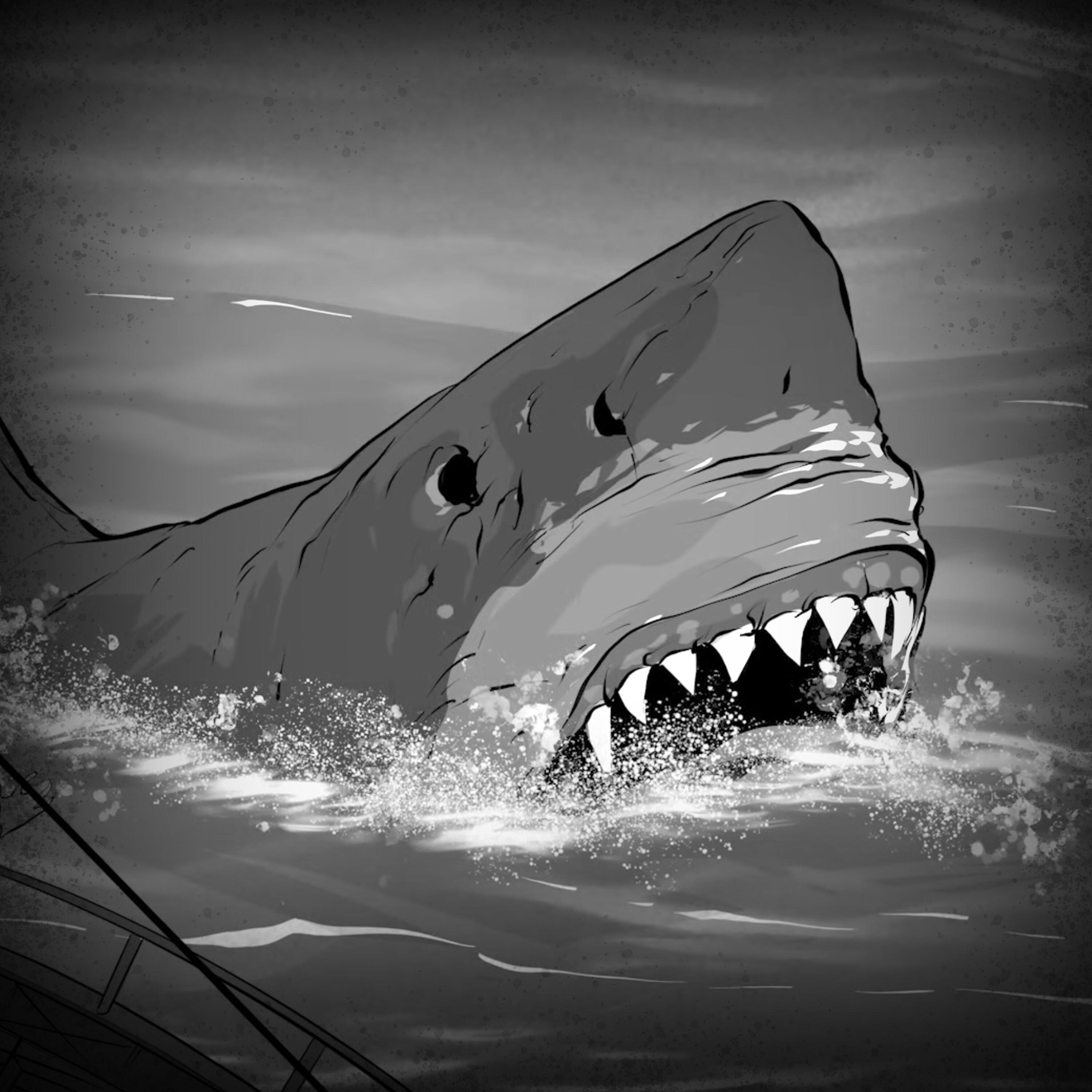The Megalodon
For as long as humans have sailed the seas, they have feared the deadly predators lurking just beneath the waves. But what if the most terrifying monster wasn’t a known species, but an ancient ghost of impossible size, a creature science says has been extinct for millions of years?
See Privacy Policy at https://art19.com/privacy and California Privacy Notice at https://art19.com/privacy#do-not-sell-my-info.
Press play and read along
Transcript
Speaker 1 If you're drawn to stories like wartime stories, you'll enjoy exploring more from Balin Studios and Wondery, like my other podcast, Redacted Declassified Mysteries.
Speaker 1 Both shows are available early and ad-free on Wondery Plus. Start your free trial today.
Speaker 1 How many of us are terrified by open water? Is it the depth that frightens us? Nothing but a vast expanse of blue fading into a dark void below?
Speaker 1 Or is it the horrible thought of what might be lurking in the darkness? Monstrous creatures and other dangers that might suddenly appear with nowhere for us to hide?
Speaker 1 For many, no ocean-dwelling predator quite captures this terror, like sharks.
Speaker 1 Stories like that of the USS Indianapolis and many other wartime shipwrecks offer us a grisly showcase of what happens to those unfortunate men who find themselves stranded in open water at the mercy of hungry sharks.
Speaker 1 While their overall reputation as cold-blooded killers is largely unfounded, the top three usual suspects in most attacks, fatal or otherwise, are the bull, tiger, and great white sharks.
Speaker 1 Great whites are by far the largest and most fearsome of all.
Speaker 1 However, amongst the world's vast seafaring community, at least for the last century, there have been more than a few whispers of a far more terrifying kind of shark, a relic from an ancient time whose enduring existence would defy all scientific explanation.
Speaker 1 And yet, the ocean remains very deep and largely unexplored. As told by adventurers, fishermen, and even sailors in the U.S.
Speaker 1 Navy, these are their true stories of encounters with what they believed to be
Speaker 1 the Megalodon.
Speaker 1 I'm Luke Lamana,
Speaker 1 and this is Wartime Stories.
Speaker 2
Now, don't go claiming up on me. I come all the way out here to this bloody island to hear the story you boys have been spreading around.
Now I'm standing here asking.
Speaker 1 Look, I'm sorry, mate.
Speaker 2 Alright, at least just tell you how big it was.
Speaker 1 It's hard to talk about. I mean,
Speaker 1
the bloody thing is massive. Ah, it's bad luck, isn't it? The more we talk about it, the more it keeps coming back.
It's best not to mention it.
Speaker 1
For many sailors taking to the high seas in the year 1918, the most feared predator lurking beneath the surface was not biological. It was man-made.
The infamous German U-boat.
Speaker 1 However, it was not the sighting of a submarine that brought David Stead, one of the era's most respected experts in the field of ocean study, to the picturesque seaside community of Port Stevens.
Speaker 1 Located on the coast of New South Wales, Stead was drawn to the humble Australian town after hearing a series of terrifying reports made by local fishermen.
Speaker 1 While tending to the various lobster traps placed along the coast, they had seen something massive swimming below their boats.
Speaker 1 Determined to put a name to this unknown sea creature, David Stead arranged a meeting with some of the men who claimed to have encountered the beast.
Speaker 1 Strangely, he found the men difficult to speak with.
Speaker 1 Even though hardened by years of sailing and being well acquainted with the many perils of the ocean, David noted that this latest experience had left them deeply troubled, if not traumatized.
Speaker 1 The men now flatly refused to venture back out onto the water and were even reluctant to describe to David what they saw.
Speaker 1 Finally managing to get them to talk, as the story goes, The fishermen told David they had set out to their usual spots, the goal being to check on the many lobster pots they had set the day prior.
Speaker 1 Just as they had reeled in the first pot, filled to the brim with lobsters, a creature, unlike anything they had ever seen, suddenly broke through the waves alongside their boat.
Speaker 1 A massive white shark, far bigger than any shark the seasoned fishermen had ever encountered, seized the entire meter-long pot in its jaws, effortlessly crushing the wood and steel frame.
Speaker 1 The fishermen, caught off guard by the shark's arrival, could only watch in stunned silence as the beast then disappeared beneath the churning waters. And that wasn't the last time it was seen.
Speaker 1 According to the men, the monster shark continued to prowl the town's fishing zones for several more days, dining on more of their lobster-filled cages. before it finally seemed to have left the area.
Speaker 1 Still, despite the beast not making another appearance, many fishermen remained remained apprehensive about getting back into the water.
Speaker 1 When David asked the men about the size of the shark in question, the responses they gave were, quite frankly, absurd. Somewhere in the range of 150 to 300 feet in length.
Speaker 1 A true fisherman's tale, if ever David had heard one. By comparison, the biggest animal known to man, the blue whale, reaches lengths of only around 110 feet.
Speaker 1 While he was certain that the measurements given by the frightened men were exaggerated, David was unable to shake the thought that the Australian fishermen had no less witnessed an unusually massive super-predator, a species long considered to have been lost to extinction.
Speaker 1 Could it be possible, he wondered, that these men had actually encountered a megalodon?
Speaker 1 The Port Stevens incident, as detailed in David Stead's posthumous 1963 book, Sharks and Rays of Australian Seas, is widely credited with igniting speculation that the prehistoric megalodon could still be prowling in the world's oceans.
Speaker 1 The story shook up the world's scientific community, the account carrying an inherent degree of credibility coming from one of the world's most renowned oceanographers.
Speaker 1 But how could such a giant shark possibly endure into the modern era?
Speaker 1 The megalodon's reign is thought to have begun some 20 million years ago in the Miocene era, eventually becoming extinct in the mid-Pliocene era, about 3.56 million years before the dawn of man.
Speaker 1 During its heyday, the megalodon is considered to have been the ancient ocean's undisputed apex predator.
Speaker 1 Though thought to be similar in anatomy to the modern great white shark, its overall proportions were far bigger.
Speaker 1 Even the largest great white is dwarfed in comparison and could easily be swallowed whole by the meg.
Speaker 1 The female megalodons spanning from approximately 44 to 59 feet in length, with some scientists contending it could reach incredible lengths of 82 feet, the megalodon is believed to have preyed on prehistoric whales and other large fish in order to satiate its massive appetite.
Speaker 1 While fossil evidence places these creatures all over the world, it is theorized that the megalodon fell victim to a number of changing environmental factors, ultimately depriving it of its vital food sources.
Speaker 1 The rise of new, smaller shark species, such as the great white, better evolved to survive in the changing environment, is thought to have ultimately driven the meg into extinction.
Speaker 1 But what if they weren't? Science has said the same about other gigantic prehistoric fish species, such as the coelacanth, until one was found alive in 1938.
Speaker 1 And just 10 years after the Port Stevens encounter, another story would rise from the waters of the Pacific Ocean, appearing to lend further credence to the megalodons' continued existence until today.
Speaker 1
Hey, it's Luke, the host of Wartime Stories. As many of you know, Mr.
Balin and Balin Studios have been a huge help in bringing this podcast to life.
Speaker 1
And if you'd like to believe you are something of a storytelling connoisseur, then you need to check out Mr. Balin's podcast, Strange, Dark, and Mysterious.
Each week, Mr.
Speaker 1 Balin weaves gripping tales of the Strange, Dark, and Mysterious, diving into true crime, unsolved mysteries, and paranormal events that keep you on the edge of your seat. Mr.
Speaker 1 Balin's podcast, Strange, Dark, and Mysterious, is available on all podcast platforms, and it is free, just like ours.
Speaker 1
There are hundreds of episodes available to binge right now with new episodes twice a week. Go listen to the Mr.
Bollin podcast today.
Speaker 3 So, there I was trying to angle for some big marlins I just heard about off Rangiora, and that's when I see it: big square head, these giant pectoral fins, and a few white spots.
Speaker 3
Absolutely massive, considerably longer than my boat, which was about 10 to 12 meters. The Kiwis with me saw it too.
We all thought it might be a whale shark, but it just looked nothing like it.
Speaker 3 Only the size of this shark was the same. Otherwise, it was in no way similar.
Speaker 3 I've landed all manner of sharks, world-record tigers, nurses, even a few makos, which incidentally I've seen jump 15 feet out of the water when hooked.
Speaker 3
But if one of them leapt over this, it would just barely clear the tail fit on this giant shark. It's unbelievable.
Never seen the like of it.
Speaker 3 When I figured out that that fish fish was not a harmless whale shark, but one of the man-eating monsters of the South Pacific,
Speaker 3 then I was more frightened than I remember for a long time.
Speaker 1 Being one of the most prolific authors of American Western novels, it is perhaps ironic that Zane Gray's true love was the open ocean.
Speaker 1 When not sitting behind his writing desk or maintaining his dental practice, Gray was setting sail on the waters around Australia and the South Pacific, indulging in his passion for deep-sea fishing.
Speaker 1 In 1928, Gray found himself casting his lines in the waters off the Rangiora Atoll in Tahiti, drawn to the area by reports of impressively oversized marlins and hoping to land one for himself.
Speaker 1 Standing on the deck of the 10-meter-long SS Manganui, Zane, his eyes scanning the waters for telltale signs of the prized marlin, suddenly noticed a huge shape drifting through the water alongside his steamship.
Speaker 1 As it broke the surface, Zane found himself gripped by both fear and amazement, seeing that this incredibly massive creature, its mottled yellow skin covered in barnacles, bore the distinct outline of a shark.
Speaker 1 During his time spent with local natives and indigenous fishermen, Gray had heard many tales about monster sharks dwelling in Polynesian waters.
Speaker 1 Now seeing one with his own eyes, Gray remembered stories about a mythical creature known locally as Magantu, the lord of the deep.
Speaker 1 Seen as a sort of deity, Magantu takes the form of a huge shark, its massive jaws capable of swallowing entire pahi sailing canoes whole.
Speaker 1 In some tellings, islanders would make sacrifices to appease the beast, while some young men even ventured out into the open water to confront him in some sort of coming-of-age right.
Speaker 1 Zane Gray, well accustomed to the largest animals in the Pacific Ocean, had thought these tales to be little more than local myth and superstition.
Speaker 1 But not anymore.
Speaker 3 Boy, I sure hope we get to see her. I'm telling you, son, the beast was huge,
Speaker 3 unlike anything I've ever seen.
Speaker 3 This here ship is white, 10 meters long, right?
Speaker 3 Well, this fish was bigger.
Speaker 1 Are you sure, Pop? There are whales out here. They get pretty big, too, don't they?
Speaker 3
No, no, no. This was no whale, son.
Sure as sunrise, that was a shark.
Speaker 1
Maybe that could be your next book, Pop. Wyatt Earp and the Monster Shark.
Ha!
Speaker 3 Well, there's an idea. But how do we get the sheriff out onto the water?
Speaker 1 Hi, we got something over there.
Speaker 1 Where? Starboard side. 500 yards.
Speaker 1 After returning home, Gray could barely contain his excitement over what he had witnessed.
Speaker 1 Eagerly telling his son about the specifics of his encounter, Lauren Gray, then at the age of 13, was more than a little skeptical.
Speaker 1 His father was a fiction writer, after all, and certainly had the imagination to show for it. Perhaps, Lauren thought, he had simply mistaken a harmless whale shark for the animal in question.
Speaker 1 Zane, however, was certain of what he saw, and it was no whale shark.
Speaker 1 Two days later, still unconvinced by his dad's account of the monster shark, Lauren would accompany his father as they sailed back out to that same patch of ocean, an outing that would confirm Zane's story and become one of the most memorable events of both of their lives.
Speaker 1 We saw birds flying erratically over a yellow-colored patch of water.
Speaker 1 The patch was the giant shark swimming just beneath the surface. And my father was right.
Speaker 1 It was not a whale shark.
Speaker 1 And just about how big would you say it was?
Speaker 1 Its tail stuck 10 feet out of the water. So you moved the boat closer, you got close enough to see it? Yeah, I looked right down at him, and the head was
Speaker 1 as wide as a room.
Speaker 1 It tip to tail, it had to be at least 50 feet long.
Speaker 1 Lauren Gray recounted this testimony in a 1994 newspaper interview.
Speaker 1 Just beneath the clear surface of the water, being orbited by seagulls, was the very monster his father had described, an unbelievably massive shark.
Speaker 1 In his 1931 book, Tales of Tahitian Waters, Zane Gray also elaborated on this second encounter, describing the shark in great detail.
Speaker 3 When the great brown tail rose in the ship's wake, I knew immediately that it was a monster shark.
Speaker 3 The huge round head appeared to be at least 10 to 12 feet across, if not more.
Speaker 3 It was my belief that this huge, yellowish, barnacled creature must have been at least 40 or 50 feet long.
Speaker 3 He was not a whale shark. The whale shark has a distinctive white, purplish-green appearance with large brown spots and much narrower head.
Speaker 3 So what was he?
Speaker 3 Perhaps a true prehistoric monster of the deep.
Speaker 1 Following Zane and Lauren Gray's account, not much appears to have been documented about massive shark sightings taking place over the following decades.
Speaker 1 The ocean is, of course, very large, and perhaps the appearance of these massive sharks is a rare sight. But at the turn of the 20th century, another group of men, U.S.
Speaker 1 Navy sailors, sailors, found themselves sailing through the waters of the South Pacific, this time closer to India.
Speaker 1 And like the Australian fishermen, they too would suddenly witness something unexpected.
Speaker 1 Water,
Speaker 1 water,
Speaker 1 water.
Speaker 1 Oh, look.
Speaker 1 More water.
Speaker 1 Yeah.
Speaker 1 It's almost like you're in the Navy or something.
Speaker 1
My recruiter said I would see the world. Hmm.
And look, this is part of the world.
Speaker 1 Mine said I would be a Navy SEAL.
Speaker 1 Yeah, I just never imagined I would find myself keeping security watch
Speaker 1 on an ocean. Didn't you ever watch Castaway, Titanic, Jaws?
Speaker 1
Never know what you might run into out here. Japanese submarine slammed two torpedoes into her side, Chief.
We were coming back from the island of Tinian to lady.
Speaker 1 We just delivered the bomb. Well, at least I know you've seen Jaws.
Speaker 1 What was that?
Speaker 1 It's just that pot of dolphins that's been following us for a while.
Speaker 1 Well, look at them go.
Speaker 1
I wish I could swim like that. My swim calls would be a lot easier.
Huh.
Speaker 1 Something wrong?
Speaker 1 I'm not sure.
Speaker 1 Never see dolphins act like that. It's like they're
Speaker 1 running from somewhere. What the hell is...
Speaker 1 Is that a whale?
Speaker 1 Sailing through the Indian Ocean sometime in the late 90s, a U.S. Navy petty officer found himself stationed on his ship's forecastle with two other crew members.
Speaker 1 Together they scanned the horizon as their vessel vessel plowed through the churning waters en route to Goa, located on the Indian coast.
Speaker 1 After hearing a series of loud heavy splashes, the petty officer peered over the deck railing, his eyes locating a pod of dolphins breaking through the waves.
Speaker 1 They had been following the ship for the past few days.
Speaker 1 The dolphins were a welcome distraction for the lookouts, the monotony of their watch shift now broken by the dolphins' playful leaping and jumping in the ship's wake.
Speaker 1 However, their graceful motions suddenly turned into panicked maneuvers as the entire pod scattered from its tight formation.
Speaker 1 Then the men saw it. Looming beneath the foaming waves and making straight for the dolphins was a massive shape.
Speaker 1 At first believing it to be a whale because of its size, the petty officer's eyes widened as the dorsal fin broke the surface. A massive shark fin.
Speaker 1
rising to a height that he estimated was at least 10 feet above the water. He couldn't believe they were witnessing a shark of that magnitude.
It had to be some kind of whale.
Speaker 1 Maybe, he thought wildly, the dolphins were being attacked by a pot of orcas. But the fin looked nothing like that of a killer whale.
Speaker 1 But then, when the animal's distinctive head breached the ocean's surface, a dolphin in its jaws, the water now turning red with blood, all doubt left his mind.
Speaker 1 The whale
Speaker 1 While the incident wouldn't go into their logbooks as an apparent whale sighting, The petty officer would catch word that the behemoth animal, whatever it was, had been picked up by the ship's underwater sonar.
Speaker 1 An acronym for sound navigation and ranging, sonar uses pulsing sound waves to map out underwater objects and terrain.
Speaker 1 The initial suspect in the dolphin attack, an orca whale, typically maxes out around 9 meters, or 29 feet in length.
Speaker 1 Whatever was picked up by the vessel's sonar, the petty officer said it came back with a reading that would put it at an astounding 25 meters long or 82 feet from nose to tail.
Speaker 1 While it is possible that the chaotic movements of the dolphins attempting to flee the unknown predator confused the sonar, it is worth mentioning that 82 feet would place the mystery shark within the megalodon's estimated growth range.
Speaker 1 The petty officer, still active in the Navy after 15 years of service, shared his encounter in January of 2000, which was then featured on the website of the Animal X Cryptozoological TV show.
Speaker 1 Despite some intriguing testimony, science argues that megalodon, at least as it once existed, would be almost incapable of surviving in today's oceans.
Speaker 1 Even in the most remote depths of the Marianas Trench, researchers are certain that it would be difficult, if not impossible, for a shark of megalodon size to remain elusive in the modern era.
Speaker 1 However, there is always the possibility that they are wrong. A story that many often point to in support of the Meg's continued existence is that of the HMS Challenger.
Speaker 1 a British Royal Navy ship that, while on a scientific expedition in the 1870s, drudged up two megalodon teeth specimens from the seabed.
Speaker 1 In 1959, Russian paleontologist Vladimir Chernezky stunned the scientific world by declaring the teeth to be 11,000 and 24,000 years old, respectively.
Speaker 1 If his dating of the megalodon teeth was accurate, that would place the shark on Earth alongside early man. then on the cusp of transitioning from the Stone Age into the bronze.
Speaker 1 Then again, many were quick to criticize Chernezky's method of measuring the manganese dioxide coating on the teeth, which has a habit of making fossils appear far younger than they actually are.
Speaker 1 So, if all signs point to the megalodon being extinct, then what could these sailors and fishermen be encountering, if not a prehistoric shark?
Speaker 1 In 2003, filmmaker David Riggs documented a scientific expedition off the coast of Bremer Bay, Australia.
Speaker 1 The primary goal of the researchers was to tag as many great white sharks as possible with electronic markers.
Speaker 1 Similar in function to an airplane's black box recorder, these tags, harmlessly embedded in the shark's cartilage, would allow the scientists to follow a shark's migration routes while also collecting data regarding the animal's depth and the temperature of its surroundings.
Speaker 1 One of the great whites tagged as a part of this study was a healthy, nearly 10-foot-long female.
Speaker 1 About four months after the expedition, the electronic tag attached to this shark was found, washed up on the Australian coast.
Speaker 1 Assuming the tracking device had merely fallen off, when it was analyzed, the data gathered by the tag both unnerved and intrigued the researchers.
Speaker 1
One thing was certain, the tag hadn't simply fallen off. The data showed that the tag was maintaining a routine depth under 900 feet.
And at 4 a.m.
Speaker 1 on Christmas Christmas Eve, the shark suddenly plunged at high speed straight down the edge of a continental shelf, finally leveling off at a depth of around 1,900 feet.
Speaker 1 What's more, despite ocean water growing colder at greater depths, as the device was descending, its temperature wasn't decreasing, but was quickly increasing from 46 degrees to 78 degrees Fahrenheit, a temperature only possible if the tracker was now inside the belly of another animal.
Speaker 1 Something had attacked and eaten the Great White.
Speaker 1 The tag remained at 78 degrees for the next eight days, meandering between a depth of 300 feet and the surface before it was finally released.
Speaker 1 Keeping their theories within reasonable boundaries, the final conclusion the researchers made was that a super predator of some kind, a colossal cannibalistic great white, was responsible for attacking and eating the 10-foot shark and its tracker.
Speaker 1 While the great white species is generally known to max out in length at about 16 feet, there are verified exceptions to this rule.
Speaker 1 In 2013, a female great white that would come to be known as deep blue was sighted for the first time off the coast of Guadalupe Island.
Speaker 1 Drifting into view of stunt researchers, Deep Blue was 21 feet in length, making her one of the largest whites ever documented.
Speaker 1 While reports of great whites exceeding 20 feet are hard to verify, she likely isn't the only one of her kind.
Speaker 1 But in regards to what would prey on a 10-foot great white, without anything but the tracker and its data to go on, this was their only theory. a larger great white shark.
Speaker 1 In the end, the shark researchers acknowledged that it simply remains a mystery, and that after so many years of human exploration, Earth's oceans still remain largely unexplored, their depths less understood than the surface of the moon.
Speaker 1 Considering the eyewitness accounts, what would you say?
Speaker 1 Is it possible that the megalodon is still out there, lurking in the depths?
Speaker 1
Wartime Stories is created and hosted by me, Luke Lamana. Executive produced by Mr.
Bollin, Nick Witters, and Zach Levitt. Written by Jake Howard and myself.
Speaker 1
Audio editing and sound design by me, Cole Acasio, and Whitlacascio. Additional editing by Davin Intag and Jordan Stidham.
Research by me, Jake Howard, Evan Beamer, and Camille Callahan.
Speaker 1 Mixed and mastered by Brendan Kane. Production supervision by Jeremy Bone.
Speaker 1 Production coordination by Avery Siegel, additional production support by Brooklyn Gooden, artwork by Jessica Klogston Kiner, Robin Vane, and Picada.
Speaker 1 If you'd like to get in touch or share your own story, you can email me at info at wartimestories.com. Thank you so much for listening to Wartime Stories.





